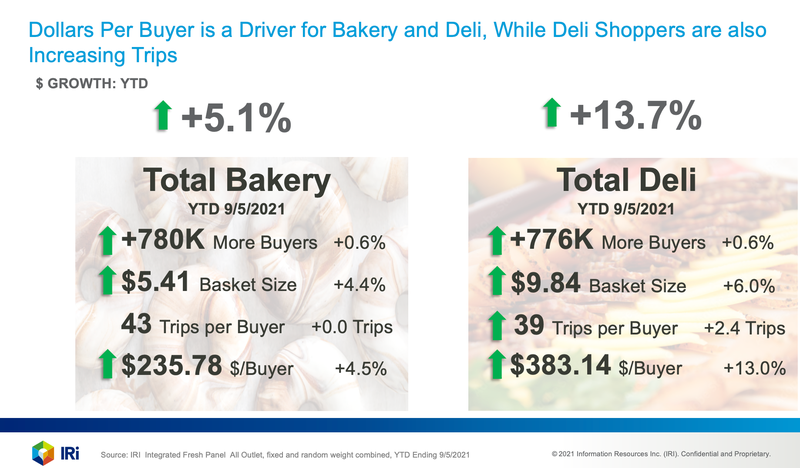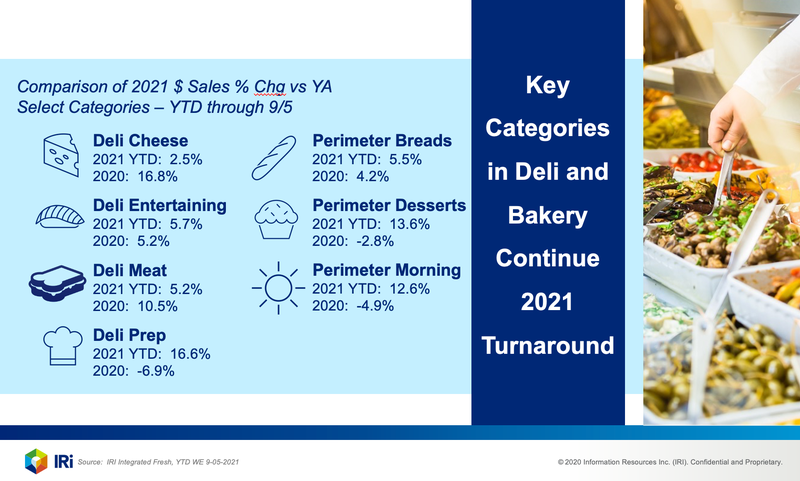Reimagining deli and bakery for today's grocery shopperReimagining deli and bakery for today's grocery shopper
From e-commerce to labor issues and more, experts from IRI and IDDBA share trends and insights for the deli and bakery departments

During our recent webinar “Reimagining Deli & Bakery,” Supermarket News was joined by Jonna Parker, principal, Fresh Center of Excellence at IRI, and Eric Richard, industry relations coordinator at the International Dairy Deli Bakery Association, who shared data and insights on those supermarket categories, the impact of COVID over the past 18 months, and what to expect going forward.
The webinar, which is available on-demand, was sponsored by Schuman Cheese, a leader in the cheese industry throughout the world.
Here are some key takeaways from the session:
1. Online and social media
"New ways of shopping absolutely include online grocery. For the most part, we do not see good, if any representation, of most deli or bakery options in online shopping forums,” IRI’s Parker noted. “Further, I think what we absolutely do see in the numbers, but we don't see enough embracing from the industry is the influencer market. Things like Pinterest and Instagram, which most of us are engaged with today.” Parker pointed to a sales spike in feta cheese earlier this year that was driven almost exclusively by big recipe trends on TikTok.
“Those types of things are not part of our purview in this industry enough,” she said. “The new ways of shopping could really drive a lot more consumer engagement.”
On e-commerce, IDDBA’s Richard noted the unprecedented surge of online grocery in 2020. “The e-commerce channel was already one of the fastest-growing channels by percentage leading into the pandemic. It just skyrocketed during the pandemic. That level of participation has stabilized for the most part since then, with another increase, a little bump during the summer months. Which means that regardless of any remaining impacts caused by the pandemic, some consumers will continue to utilize online shopping, pickup and delivery options while also physically shopping the store.”
He added, “Walking a physical store is obviously different than walking a virtual one. Creating that engaging and efficient virtual experience is really important. Online selection inventory, as well as search capabilities, that's also critical. More customers are shopping online and it's important that e-commerce platforms help find what they're looking for. Like most of these current trends, grocery e-commerce wasn't born out of the COVID-19 pandemic, but the pandemic did bring it to the forefront of consumer shopping behaviors.”
2. Impact of labor shortages
“Labor shortages are being felt storewide,” said Richard, “but perhaps even more so in the fresh departments given the necessity of associates to not only prepare products, but also engage with the shoppers. If the current trajectory continues, we could see greater use of automation for some department processes. In fact, while we often associate trends with new flavors, ingredients and tastes, a new trend might be focused on equipment and technology. Process-based, efficiency-based and convenience-based ways of ensuring that products keep up with consumer demand for of them. That's one possible solution.
“Another is a use of the commissary model whereby the production component is almost run like a separate deli prep or bakery area, for example, to provide a central location for baking or preparing products for several stores. Baker-prepared in the store, but not part of the store. Essentially a commissary within a store. Labor shortages and challenges were an issue even before the pandemic began. It's most likely to remain a challenge for the food retail industry going forward.”
3. Supply chain
“Just as the labor shortage has impacted almost all industries, so too has the disruption of the supply chain,” said Richard (left). “Whether due to inadequate labor plant closures, impact of tariffs, limited supply of raw materials or insufficient number of trucks and other transportation, this impact continues to be felt within the food retail sectors. What we saw during the pandemic and currently as well are product shortages, SKU rationalization and a more limited assortment of products.
“Retailers are responding in several ways to this. Some have partnered with local bakeries and restaurants to offer their products within their stores as well as local producers, including those who offer specialty products. Retailers have told me that they're communicating more frequently with their suppliers on how to properly address these shortages. Maintaining frequent communication with suppliers is one way to tackle this issue.”
4. Premiumization in the perimeter
“We know that people are cooking more at home than ever, but by the time they make their roast or their mashed potatoes from scratch, they might not just want to have sandwich bread,” said IRI's Parker. “They might really want to elevate that with an artisan sourdough, for example, a fresh and ready loaf from the fresh bakery. That's why we're seeing such strong trends. Perimeter desserts, perimeter morning... Perimeter did suffer last year because people were looking for things that could sit in their home for longer and we weren't celebrating. This year changed that. I think especially the retailers who are favoring smaller sizes, so maybe two or three kinds of serving sizes are doing extremely well.”

5. Shoppers with a mission
“When it comes to deli and bakery, showrooming — showing beautiful options for impulse or inspiration — has always been a big part of those departments. It's important to note that we are seeing people, shoppers take fewer trips to stores,” Parker said. “When they go to the store, they have a mission in mind. Now, favorably this year, that mission is I'm having the neighbors over after we all got vaccinated, or I haven't seen Grandma in a while and now that our COVID rates are lower, I'll have her over. Those types of missions actually favor deli and bakery and that’s a big part of what we're seeing in the numbers in 2021.”
6. Growth in frozen
“Even when we look at the fact that we're back this year, we're still only up in deli 11.9% versus 2019 pre-pandemic rates,” Parker said. “That sounds awesome and we're probably taking a victory lap — except when we look across the other parts of the store. Take a look at frozen food. I argue that frozen food is actually the closest cousin in the store to deli, especially deli prep. Frozen's up 22% versus pre-pandemic. Whether they be single-serve or family meals, frozen really has centered in on what consumers want. We don't see a lot of those options in the deli.”
7. Getting creative
“As we near the holidays, think about how your deli and bakery can be an entertaining destination with ideas, creativity, maybe Pinterest or TikTok-ready, Instagramable-type digital engagements. That is going to really be what consumers want and need as we go into the holidays. We're ready for an excellent holiday, and maybe we're not going to celebrate with 25 people, but the five to 10 people we're going to celebrate with, we want to impress. Deli and bakery needs to be there for us,” said Parker.

8. Convenience factor
As IDDBA’s Richard pointed out, some of the eating trends we saw increase during the pandemic are still very relevant. For example, grab and go options, including meal kits and heat-and-eat options. During the height of the pandemic, consumers were purchasing these for the week while working at home or preparing meals for kids that were in virtual classroom settings. The same goes for pre-sliced and prepackaged meats and cheeses. “But these products continue to see high demand,” said Richard, “which makes me believe that convenience is still an important factor for consumers physically shopping in store.”
9. Solution center
Overall, trends all are changing, noted Parker. “What the consumers need today and who is resonating with your deli and bakery probably looks different than pre-pandemic. We really need to take a look at how the total store can be a solution center anchored by deli and bakery,” she said. “Or on the flip side, if you're not getting strong basket conversion in your deli bakery among shoppers in your store, take a look at how you can partner those opportunities with things. Let's say in the frozen, dairy or center store departments. People need to create a meal. Why make them chase all over town to find the things that they need?”
About the Author
You May Also Like






